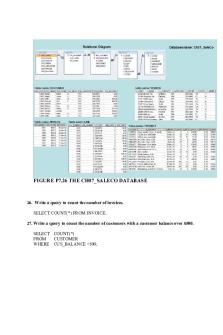Consuming Grief Ch7 - Lecture notes 7 PDF

| Title | Consuming Grief Ch7 - Lecture notes 7 |
|---|---|
| Course | Cultural Anthropology |
| Institution | Trent University |
| Pages | 3 |
| File Size | 83.3 KB |
| File Type | |
| Total Downloads | 12 |
| Total Views | 152 |
Summary
anthropology...
Description
Courtney Pleva, October 19, 2010 Conklin, Beth A. Consuming Grief: Compassionate Cannibalism in an Amazonian Society. Austin, TX: University of Texas, 2001. Chapter 7: Embodied Identities, Pages 132-156 Summary This chapter examines how the Wari do not see the outer form of a person as a symbol for identity, but they see the body as the site where personal identity exists and social relationships develop. The two major aspects of the Wari’ person, (jami-) and (kwere-), spirit and body respectively, are described. All human beings have a spirit which resides in the body. A spirit may leave the body during dreams, serious illnesses, or deep emotional malaise and when this happens, the body loses consciousness fully or partially. The spirit leaving the body usually is an omen for death in the near future. Unhappy spirits will often leave the body and this is why food and personal belongings are constantly being shared among neighbors and family. This also is why physical contact amongst community members is crucial to the Wari. This physicality is used even during illness and death, which is why the Wari are constantly holding their dead while they are mourning and keening. Wari do not merely see the body as a material entity, it is also connected to emotion, thought, knowledge, personality, and morality. The brain and eyes are also closely connected and visual recognition relates greatly to cognitive processes, which is part of the reason all visual reminders of the dead are destroyed (ie: personal belongings, crops, and the actual body). Question 1 The main point of this chapter is that Wari' do not see the outer form of the person as a symbol/metaphor for identity, they see the body as the site where personal identity exists and social relationships develop. 1
Question 2—Vocabulary malaise Definition: : an indefinite feeling of debility or lack of health often accompanying or leading to the onset of sickness. Cited: "which happens during dreams, serious illnesses, or deep emotional malaise." Chapter 7, p. 134
Question 3 The data presented in this chapter is both historical and ethnographic. Question 4 The data was collected through interviews with the Wari tribe elders, and Beth took fieldnotes during these interviews and also while simply observing the village.
Question 5 This chapter deepened the reader’s understanding of why the Wari had some of the traditions that they did in the past, and also those that they still have today. This includes constant physical contact, removing all material belongings of those who pass away, and why destroying the body during cannibalism was seen as okay. This strengthened the thesis that cannibalism did exist within this tribe and that it was for no reason other than to properly mourn the loss of their loved ones. Question 6
This chapter is a continuation of ideas presented in previous chapters. It further explained how important one’s blood is to the Wari and for what reasons blood must be kept healthy, flowing, and thick.
2
Question 7
Essay: 1. According to the text in Chapter 7, why do the Wari destroy all of the material belongings of the recently deceased? 2. Why is physical contact so crucial to the Wari when their close family members and friends are sick or dying?
Fill-in-the-blank: 1. The spirit leaving the body is usually an omen for _____ according to the Wari. 2. Unhappy spirits will leave the body, so _____ and _________ are usually shared within the tribe to keep members happy and feeling like they belong.
Question 8
This chapter helped me to understand some of the reasons the Wari had for traditions such as destroying material objects owned by the recently deceased, or completely stopping all conversations about them. Previously I had thought this to be a little excessive and unnecessary, but this chapter strengthened my understanding and opened my mind a bit.
3...
Similar Free PDFs

Ch7 22 - Lecture notes 7
- 26 Pages

Consuming Kids - Lecture notes 1
- 2 Pages

HTH 210 CH 7 - Lecture notes ch7
- 2 Pages

ACCT230 Ch7 - Lecture notes 5
- 60 Pages

Grief
- 6 Pages

Chapter 7 - CH7
- 18 Pages

Ch 7 - ch7
- 2 Pages

Death, Loss Grief - notes
- 1 Pages

7 - Lecture notes 7
- 1 Pages

7 - Lecture notes 7
- 3 Pages

Lecture notes, lecture 7
- 22 Pages

Lecture notes, lecture 7
- 3 Pages

Ch7 - Ch7
- 11 Pages
Popular Institutions
- Tinajero National High School - Annex
- Politeknik Caltex Riau
- Yokohama City University
- SGT University
- University of Al-Qadisiyah
- Divine Word College of Vigan
- Techniek College Rotterdam
- Universidade de Santiago
- Universiti Teknologi MARA Cawangan Johor Kampus Pasir Gudang
- Poltekkes Kemenkes Yogyakarta
- Baguio City National High School
- Colegio san marcos
- preparatoria uno
- Centro de Bachillerato Tecnológico Industrial y de Servicios No. 107
- Dalian Maritime University
- Quang Trung Secondary School
- Colegio Tecnológico en Informática
- Corporación Regional de Educación Superior
- Grupo CEDVA
- Dar Al Uloom University
- Centro de Estudios Preuniversitarios de la Universidad Nacional de Ingeniería
- 上智大学
- Aakash International School, Nuna Majara
- San Felipe Neri Catholic School
- Kang Chiao International School - New Taipei City
- Misamis Occidental National High School
- Institución Educativa Escuela Normal Juan Ladrilleros
- Kolehiyo ng Pantukan
- Batanes State College
- Instituto Continental
- Sekolah Menengah Kejuruan Kesehatan Kaltara (Tarakan)
- Colegio de La Inmaculada Concepcion - Cebu


